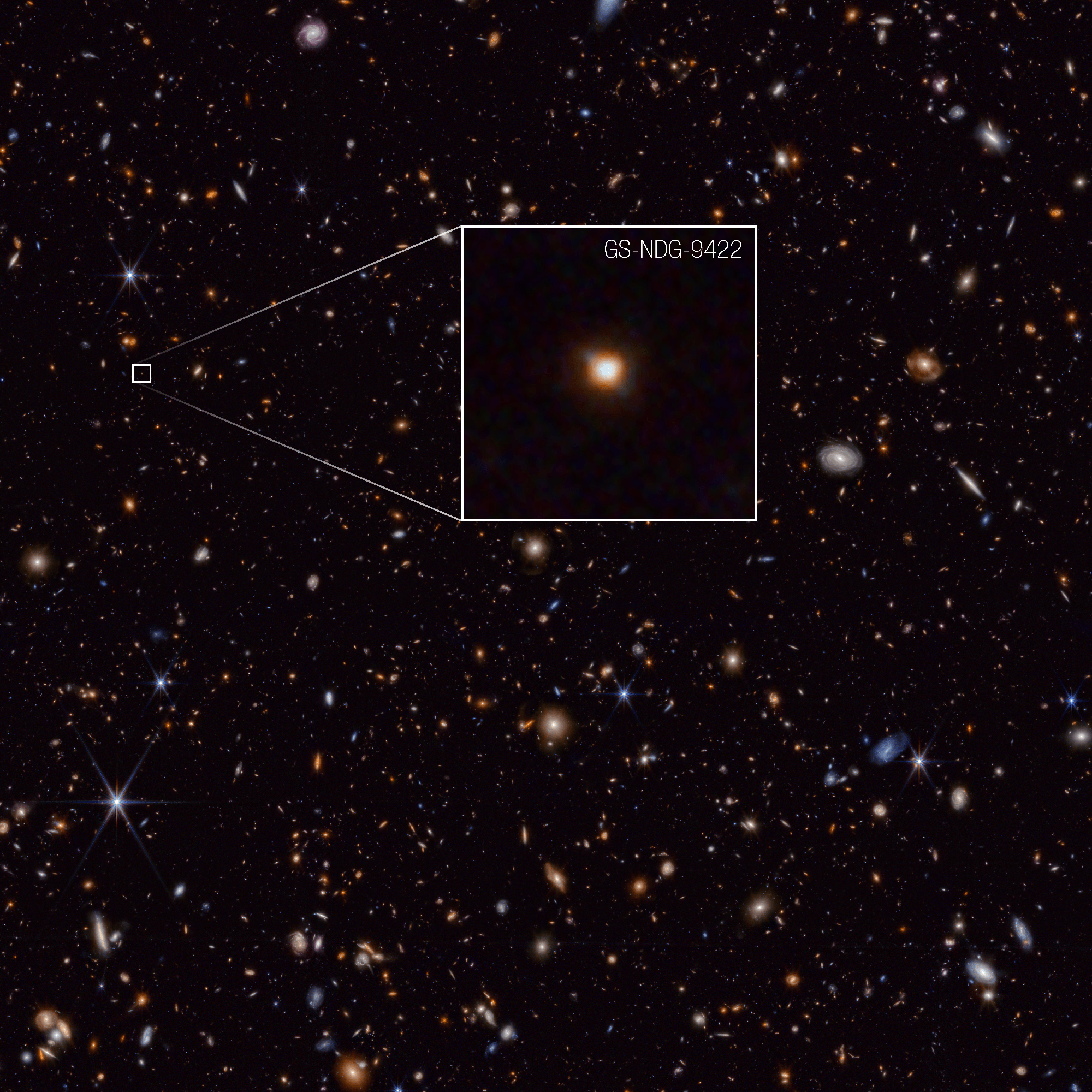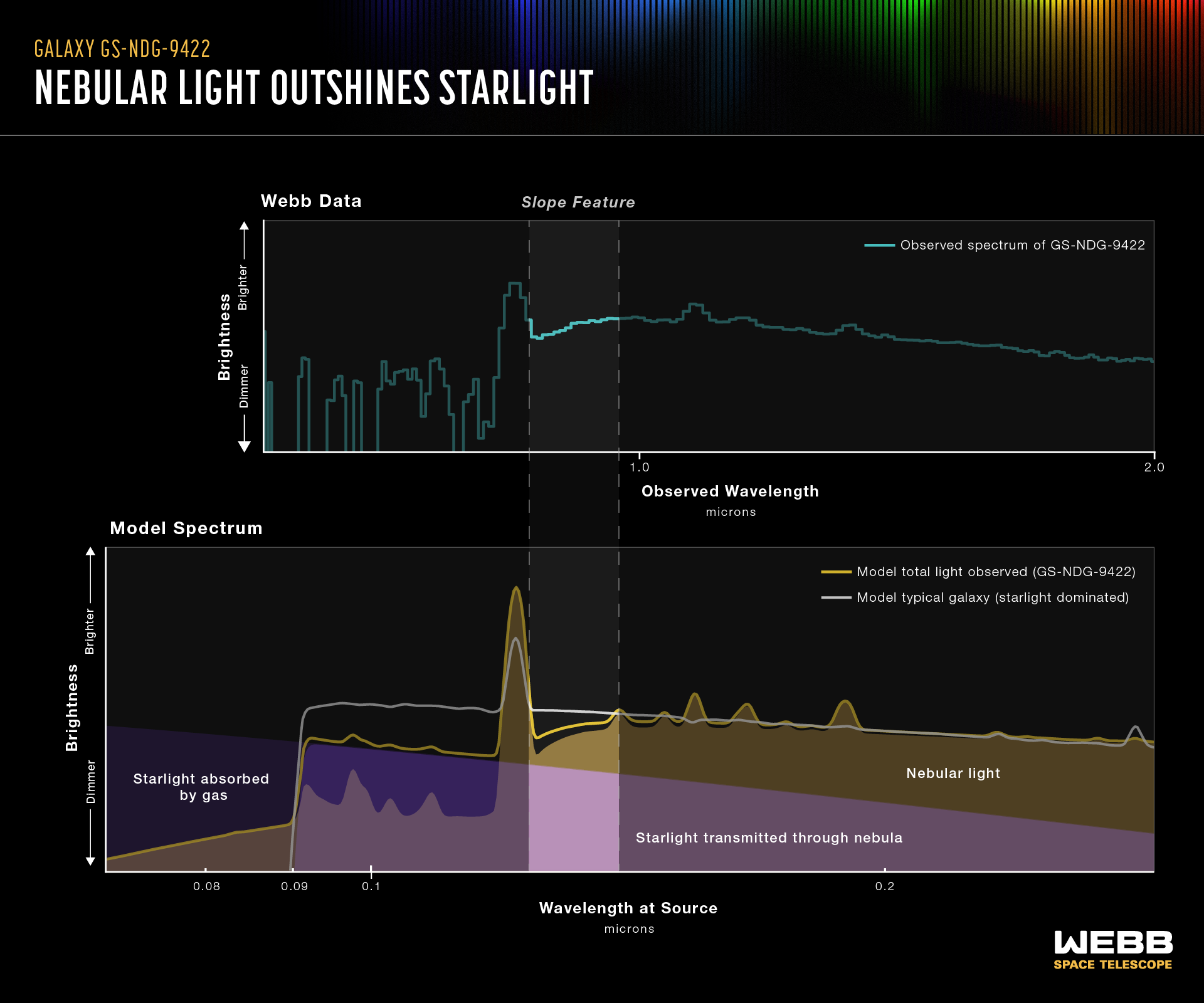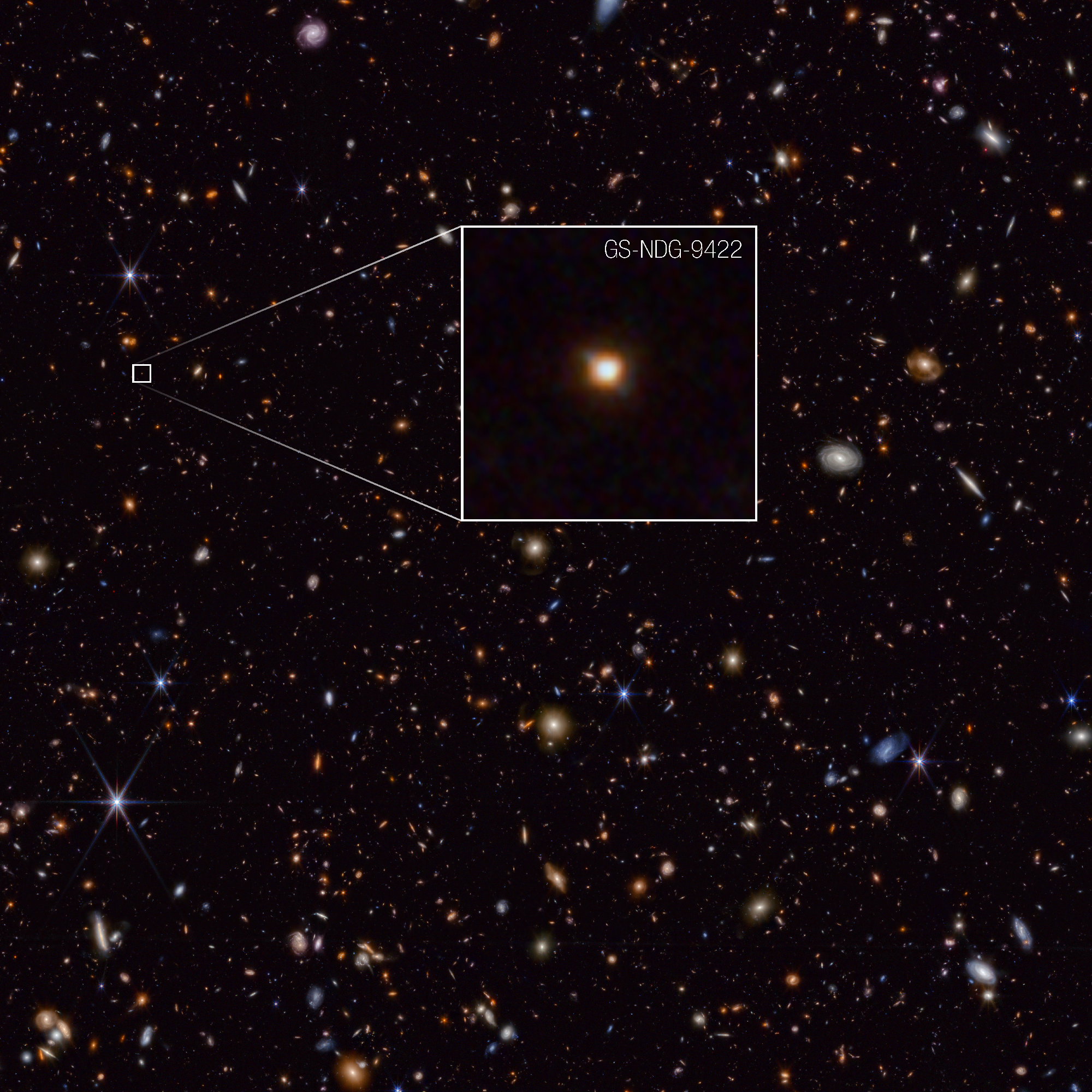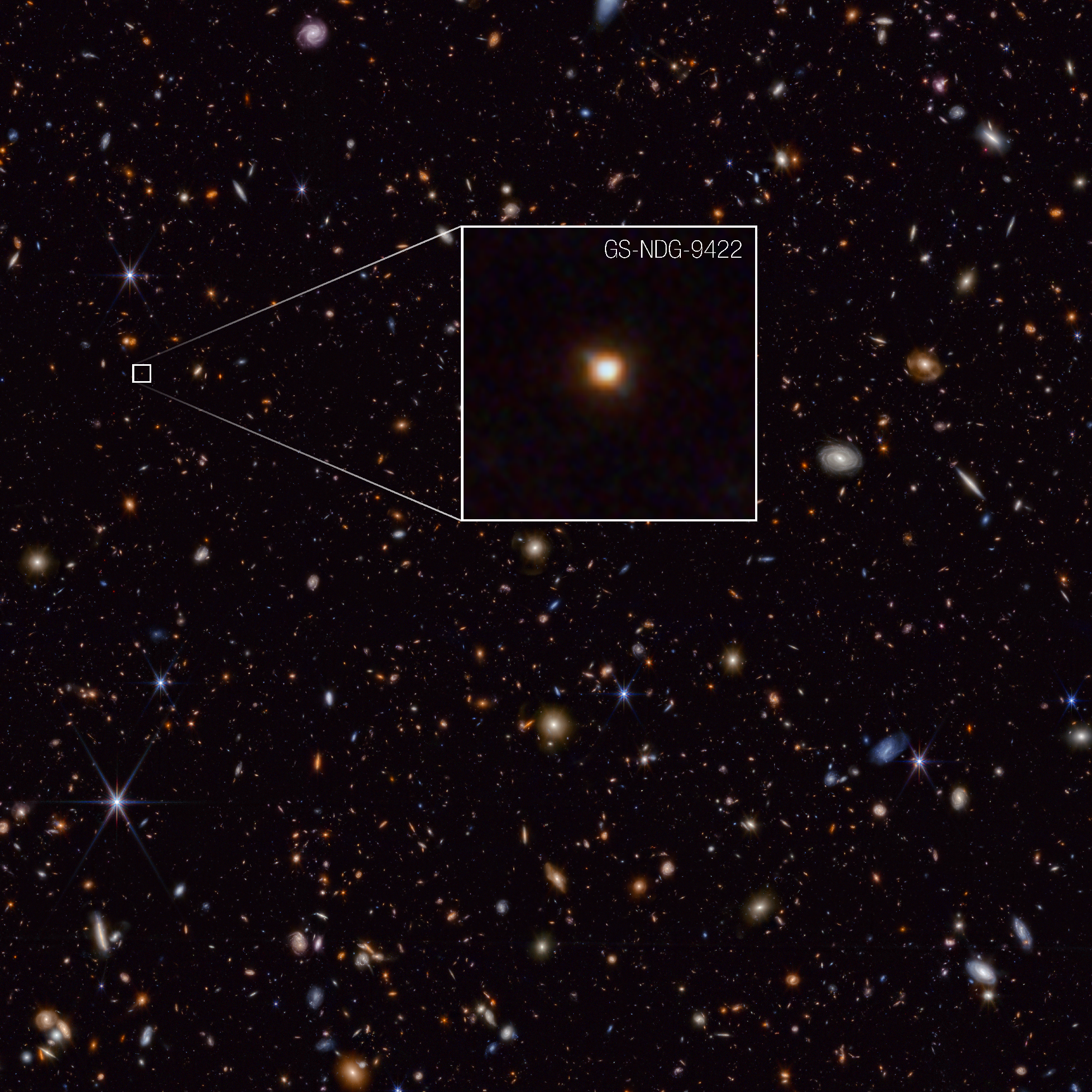4 Min Read In Odd Galaxy, NASA’s Webb Finds Potential Missing Link to First Stars  What appears as a faint dot in this James Webb Space Telescope image may actually be a groundbreaking discovery. Full image and details below. Credits: NASA, ESA, CSA, STScI, Alex Cameron (Oxford) Looking deep into the early universe with NASA’s James Webb Space Telescope, astronomers have found something unprecedented: a galaxy with an odd light signature, which they attribute to its gas outshining its stars. Found approximately one billion years after the big bang, galaxy GS-NDG-9422 (9422) may be a missing-link phase of galactic evolution between the universe’s first stars and familiar, well-established galaxies.
What appears as a faint dot in this James Webb Space Telescope image may actually be a groundbreaking discovery. Full image and details below. Credits: NASA, ESA, CSA, STScI, Alex Cameron (Oxford) Looking deep into the early universe with NASA’s James Webb Space Telescope, astronomers have found something unprecedented: a galaxy with an odd light signature, which they attribute to its gas outshining its stars. Found approximately one billion years after the big bang, galaxy GS-NDG-9422 (9422) may be a missing-link phase of galactic evolution between the universe’s first stars and familiar, well-established galaxies.
Image A: Galaxy GS-NDG-9422 (NIRCam Image)  What appears as a faint dot in this James Webb Space Telescope image may actually be a groundbreaking discovery. Detailed information on galaxy GS-NDG-9422, captured by Webb’s NIRSpec (Near-Infrared Spectrograph) instrument, indicates that the light we see in this image is coming from the galaxy’s hot gas, rather than its stars. Astronomers think that the galaxy’s stars are so extremely hot (more than 140,000 degrees Fahrenheit, or 80,000 degrees Celsius) that they are heating up the nebular gas, allowing it to shine even brighter than the stars themselves.NASA, ESA, CSA, STScI, Alex Cameron (Oxford) “My first thought in looking at the galaxy’s spectrum was, ‘that’s weird,’ which is exactly what the Webb telescope was designed to reveal: totally new phenomena in the early universe that will help us understand how the cosmic story began,” said lead researcher Alex Cameron of the University of Oxford.
What appears as a faint dot in this James Webb Space Telescope image may actually be a groundbreaking discovery. Detailed information on galaxy GS-NDG-9422, captured by Webb’s NIRSpec (Near-Infrared Spectrograph) instrument, indicates that the light we see in this image is coming from the galaxy’s hot gas, rather than its stars. Astronomers think that the galaxy’s stars are so extremely hot (more than 140,000 degrees Fahrenheit, or 80,000 degrees Celsius) that they are heating up the nebular gas, allowing it to shine even brighter than the stars themselves.NASA, ESA, CSA, STScI, Alex Cameron (Oxford) “My first thought in looking at the galaxy’s spectrum was, ‘that’s weird,’ which is exactly what the Webb telescope was designed to reveal: totally new phenomena in the early universe that will help us understand how the cosmic story began,” said lead researcher Alex Cameron of the University of Oxford.
Cameron reached out to colleague Harley Katz, a theorist, to discuss the strange data. Working together, their team found that computer models of cosmic gas clouds heated by very hot, massive stars, to an extent that the gas shone brighter than the stars, was nearly a perfect match to Webb’s observations.
“It looks like these stars must be much hotter and more massive than what we see in the local universe, which makes sense because the early universe was a very different environment,” said Katz, of Oxford and the University of Chicago.
In the local universe, typical hot, massive stars have a temperature ranging between 70,000 to 90,000 degrees Fahrenheit (40,000 to 50,000 degrees Celsius). According to the team, galaxy 9422 has stars hotter than 140,000 degrees Fahrenheit (80,000 degrees Celsius).
The research team suspects that the galaxy is in the midst of a brief phase of intense star formation inside a cloud of dense gas that is producing a large number of massive, hot stars. The gas cloud is being hit with so many photons of light from the stars that it is shining extremely brightly.
Image B: Galaxy GS-NDG-9422 Spectrum (NIRSpec)  This comparison of the data collected by the James Webb Space Telescope with a computer model prediction highlights the same sloping feature that first caught the eye of astronomer Alex Cameron, lead researcher of a new study published in Monthly Notices of the Royal Astronomical Society. The bottom graphic compares what astronomers would expect to see in a “typical” galaxy, with its light coming predominantly from stars (white line), with a theoretical model of light coming from hot nebular gas, outshining stars (yellow line). The model comes from Cameron’s collaborator, theoretical astronomer Harley Katz, and together they realized the similarities between the model and Cameron’s Webb observations of galaxy GS-NDG-9422 (top). The unusual downturn of the galaxy’s spectrum, leading to an exaggerated spike in neutral hydrogen, is nearly a perfect match to Katz’s model of a spectrum dominated by super-heated gas. While this is still only one example, Cameron, Katz, and their fellow researchers think the conclusion that galaxy GS-NDG-9422 is dominated by nebular light, rather than starlight, is their strongest jumping-off point for future investigation. They are looking for more galaxies around the same one-billion-year mark in the universe’s history, hoping to find more examples of a new type of galaxy, a missing link in the history of galactic evolution.NASA, ESA, CSA, Leah Hustak (STScI) In addition to its novelty, nebular gas outshining stars is intriguing because it is something predicted in the environments of the universe’s first generation of stars, which astronomers classify as Population III stars.
This comparison of the data collected by the James Webb Space Telescope with a computer model prediction highlights the same sloping feature that first caught the eye of astronomer Alex Cameron, lead researcher of a new study published in Monthly Notices of the Royal Astronomical Society. The bottom graphic compares what astronomers would expect to see in a “typical” galaxy, with its light coming predominantly from stars (white line), with a theoretical model of light coming from hot nebular gas, outshining stars (yellow line). The model comes from Cameron’s collaborator, theoretical astronomer Harley Katz, and together they realized the similarities between the model and Cameron’s Webb observations of galaxy GS-NDG-9422 (top). The unusual downturn of the galaxy’s spectrum, leading to an exaggerated spike in neutral hydrogen, is nearly a perfect match to Katz’s model of a spectrum dominated by super-heated gas. While this is still only one example, Cameron, Katz, and their fellow researchers think the conclusion that galaxy GS-NDG-9422 is dominated by nebular light, rather than starlight, is their strongest jumping-off point for future investigation. They are looking for more galaxies around the same one-billion-year mark in the universe’s history, hoping to find more examples of a new type of galaxy, a missing link in the history of galactic evolution.NASA, ESA, CSA, Leah Hustak (STScI) In addition to its novelty, nebular gas outshining stars is intriguing because it is something predicted in the environments of the universe’s first generation of stars, which astronomers classify as Population III stars.
“We know that this galaxy does not have Population III stars, because the Webb data shows too much chemical complexity. However, its stars are different than what we are familiar with – the exotic stars in this galaxy could be a guide for understanding how galaxies transitioned from primordial stars to the types of galaxies we already know,” said Katz.
At this point, galaxy 9422 is one example of this phase of galaxy development, so there are still many questions to be answered. Are these conditions common in galaxies at this time period, or a rare occurrence? What more can they tell us about even earlier phases of galaxy evolution? Cameron, Katz, and their research colleagues are actively identifying more galaxies to add to this population to better understand what was happening in the universe within the first billion years after the big bang.
“It’s a very exciting time, to be able to use the Webb telescope to explore this time in the universe that was once inaccessible,” Cameron said. “We are just at the beginning of new discoveries and understanding.”
The research paper is published in Monthly Notices of the Royal Astronomical Society.
The James Webb Space Telescope is the world’s premier space science observatory. Webb is solving mysteries in our solar system, looking beyond to distant worlds around other stars, and probing the mysterious structures and origins of our universe and our place in it. Webb is an international program led by NASA with its partners, ESA (European Space Agency) and CSA (Canadian Space Agency).
Downloads Right click any image to save it or open a larger version in a new tab/window via the browser’s popup menu.
View/Download all image products at all resolutions for this article from the Space Telescope Science Institute.
View/Download the research results from the Monthly Notices of the Royal Astronomical Society.
Media Contacts Laura Betz – laura.e.betz@nasa.gov, Rob Gutro – rob.gutro@nasa.gov
NASA’s Goddard Space Flight Center, Greenbelt, Md.
Christine Pulliam – cpulliam@stsci.edu, Leah Ramsay – lramsay@stsci.edu
Space Telescope Science Institute, Baltimore, Md.
Related Information Read more: “What Were the First Stars Like?”
Watch: “Massive Stars: Engines of Creation”
Learn about spectroscopy: “Spectroscopy 101 – Introduction”
Related For Kids What is a galaxy?
En Español Ciencia de la NASA
Keep Exploring Related Topics James Webb Space Telescope Webb is the premier observatory of the next decade, serving thousands of astronomers worldwide. It studies every phase in the…






